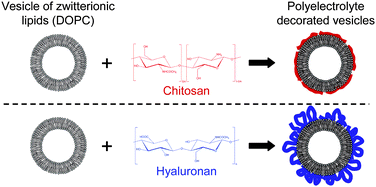Decoration of lipidvesicles by polyelectrolytes: mechanism and structure
Abstract
This study deals with

* Corresponding authors
a
Laboratoire d'Electronique Moléculaire Organique et Hybride/UMR 5819 SPrAM (CEA-CNRS-UJF)/INAC/CEA-Grenoble, 38054 Grenoble Cedex 9, France
E-mail:
brigitte.pepin-donat@cea.fr
Fax: +33 (0) 4 38 78 51 13
Tel: +33 (0) 4 38 78 38 06
b Physics Department, University of Konstanz, 78457 Konstanz, Germany
c Centre de Recherches sur les Macromolécules Végétales (CERMAV-CNRS) affiliated with Joseph Fourier University, BP53, 38041 Grenoble Cedex 9, France
This study deals with

 Please wait while we load your content...
Something went wrong. Try again?
Please wait while we load your content...
Something went wrong. Try again?
F. Quemeneur, M. Rinaudo, G. Maret and B. Pépin-Donat, Soft Matter, 2010, 6, 4471 DOI: 10.1039/C0SM00154F
To request permission to reproduce material from this article, please go to the Copyright Clearance Center request page.
If you are an author contributing to an RSC publication, you do not need to request permission provided correct acknowledgement is given.
If you are the author of this article, you do not need to request permission to reproduce figures and diagrams provided correct acknowledgement is given. If you want to reproduce the whole article in a third-party publication (excluding your thesis/dissertation for which permission is not required) please go to the Copyright Clearance Center request page.
Read more about how to correctly acknowledge RSC content.
 Fetching data from CrossRef.
Fetching data from CrossRef.
This may take some time to load.
Loading related content
